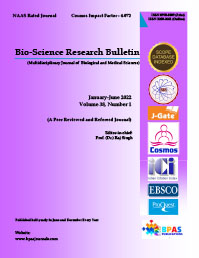Screening of the Phytochemicals of Sugarcane juice and its Potential Health Aspects
DOI:
https://doi.org/10.48165/bpas.2023.39.1.3%20Keywords:
Sugarcane juice, Phytochemical Profile, Sugarcane Wax, Health AspectsAbstract
Originally from tropical South Asia and Southeast Asia, sugarcane (Saccharum officinarum Linn.) is a significant perennial grass of the Poaceae family. Due to the high yielding plant's valuable medical and economic products, it is grown all over the world. Sugarcane juice is widely recognized as a raw material for the manufacturing of refined sugar. Although the main end result of sugarcane juice is refined sugar, additional important products including brown sugar, molasses and jaggery can also be produced during processing. In India, sugarcane juice is frequently used to cure urinary illnesses such anuria, dysuria, bleeding, and jaundice. In the present work, the many phytoconstituents and health advantages of sugarcane and its useful products are fatty acids, alcohol, phytosterols, higher terpenoids, flavonoids, -O- and -C-glycosides phenolic acids and its derivatives have been found in sugarcane leaves, juice and wax. The wax from sugarcane juice is being studied as a possible replacement for pricey carnauba wax, which has aesthetic and medicinal uses.
References
Abbas, A. K., Benoist, C., Bluestone, J. A., Campbell, D. J., Ghosh, S., Hori, S. & Ziegler, S. F. (2013). Regulatory T cells: recommendations to simplify the nomenclature. Nature immunology, 14(4), 307-308.
Anis M. & Iqbal M. (1986). Antipyretic utility of some Indian plants in traditional medicine. Filoterpia, 57, 52-5.
Ankri, S. & Mirelman, D. (1999). Antimicrobial properties of allicin from garlic. Microbes and infection, 1(2), 125-129.
Cáceres, A., Girón, L. M., Alvarado, S. R., & Torres, M. F. (1987). Screening of
antimicrobial activity of plants popularly used in Guatemala for the treatment of dermatomucosal diseases. Journal of ethnopharmacology, 20(3), 223-237.
Colombo, R., Yariwake, J. H., Queiroz, E. F., Ndjoko, K. & Hostettmann, K. (2009). On line identification of minor flavones from sugarcane juice by LC/UV/MS and post column derivatization. Journal of the Brazilian Chemical Society, 20, 1574-1579.
Cushnie, T. T., & Lamb, A. J. (2005). Antimicrobial activity of flavonoids. International journal of antimicrobial agents, 26(5), 343-356.
Darbre, P.D., Aljarrah, A., Mille,r W.R., Coldham, N.G., Sauer, M.J. & Pope, G.S. (2004). Concentrations of parabens in human breast tumours. Journal of Applied Toxicology: An International Journal, 24(1):5- 13.
deArmas, R., Martinez, M., Vicente, C., & Legaz, M. E. (1999). Free and conjugated polyamines and phenols in raw and alkaline-clarified sugarcane juices. Journal of Agricultural and Food Chemistry, 47(8), 3086- 3092.
Duarte-Almeida, J. M., Negri, G., Salatino, A., de Carvalho, J. E., & Lajolo, F. M. (2007). Antiproliferative and antioxidant activities of a tricinacylated glycoside from sugarcane (Saccharum officinarum) juice. Phytochemistry, 68(8), 1165-1171.
Evans, J.R. & Lindsay, W.M. (2002). The management and control of quality. Cincinnati, OH: South-western.
Evans, J. R., & Lindsay, W. M. (1978). The management and control of quality.
Evans, W. C. (1998). Trease and Evans Pharmacognosy 14th edition WB Saunders Company Limited.
Evans, W.C. (1989). Trease and Evans phamacognosy 13 Edition Bailere Traiadal London, pp. 101-104.
Farber, L., Carpenter, F.G. & McDonald, E.J. (1971). Separation of colorants from cane sugar. Int Sugar J. 69, 323-8.
Harbone, I. B. (1999). baxter, H. ,‘‘The Hand Book to flavonoid pigments ‘‘.
Harvey PW, Everett DJ. (2004). Significance of the detection of esters of phydroxybenzoic acid (parabens) in human
breast tumours. Journal of Applied Toxicology: An International Journal, 24(1):1-4.
Havsteen, B. J. B. P. (1983). Flavonoids, a class of natural products of high pharmacological potency. Biochemical pharmacology, 32(7), 1141-1148.
James G. 2nd ed. London: Blackwell Publishing Ltd; 2004. Sugarcane; pp. 152-7. 19. Karthikeyan, J. & Simipillai, S.S. (2010) Sugarcane in therapeutics. J Herb Med Toxicol., 4, 9-14.
Khare CP. (2007). New York: Springer Science; Indian Medicinal Plants: An Illustrated Dictionary.
Koh, H.L., Chua, T.K. & Tan, C.H. (2009). Singapore: World Scientific Publishing; A Guide to Medicinal Plants: An Illustrated Scientific and Medical Approach; p. 13.
Mahesh, B. & Satish, S. (2008). Antimicrobial activity of some important medicinal plant against plant and human pathogens. World journal of agricultural sciences, 4(5), 839-43.
Maurício Duarte-Almeida, J., Novoa, A.V., Linares, A.F., Lajolo, F.M. & Inés Genovese, M. (2006). Antioxidant activity of phenolic compounds from sugar cane (Saccharum officinarum L.) juice. Plant Foods Hum Nutr. 61, 187-92.
McGhie, T.K. (1993). Analysis of sugar cane flavonoids by capillary zone electrophoresis. J Chromatogr, 634, 107-12.
Mori, S. & Nishizawa, N. (1987). Methionine as a dominant precursor of phytosiderophores in Graminaceae plants. Plant and cell physiology, 28 (6), 1081-92.
Oluduro, A.O. (2012). Evaluation of antimicrobial properties and nutritional potentials of Moringaoleifera Lam. leaf in South-Western Nigeria. Malaysian Journal of Microbiology. 18(2), 59-67.
Ratrout, N.T. & Rahman, S.M. (2009). A comparative analysis of currently used microscopic and macroscopic traffic simulation software. The Arabian Journal for Science and Engineering, 34(1B), 121-33.
Shah, H., Naseer, A., Gupta, N., Patil, S. M., Upadhyay, S. K., & Singh, R. (2021). Proximate analysis and phytochemistry of different plant parts of Myricaesculenta extracts. Plant Cell Biotechnology and Molecular Biology, 90-102.
Silvia, A.V., Natali, G.S. & Milton, B.N. (2009). Polycyclic aromatic hydrocarbons in sugarcane juice. Food Chem., 116, 391-4.
Smith, P. & Paton, N. H. (1995). Sugarcane flavonoids. Sugar Technol Rev.12, 117-42. 31. Soetan, K. O., Ajibade, T. O. &Akinrinde, A. S. (2014). Saponins; a ubiquitous phytochemical: a review of its biochemical, physiological and pharmacological effects. Recent Prog. Med. Plants, 43, 1-24. 32. Sofowora. E.A. (1982) medicinal Plants and Traditional Medicine in Africa. John Wiley and Sons, Chichester, p. 256.
Tsuchiya, H., &Linuma, M. (2000). Reduction of Membrane fluidity by
antibacterial sophoraflavone G. isolated from Sophoraexigua. Phytomedicine, 7, 161- 165.
Vedavathy, S., Rao, K. N., Rajaiah, M., & Nagaraju, N. (1991). Folklore information from Rayalaseema region, Andhra Pradesh for family planning and birth control. International journal of pharmacognosy, 29(2), 113-116.
Vila, F. C., Colombo, R., Lira, T. O. D., & Yariwake, J. H. (2008). HPLC microfractionation of flavones and antioxidant (radical scavenging) activity of Saccharum officinarum L. Journal of the Brazilian Chemical Society, 19, 903-908.
